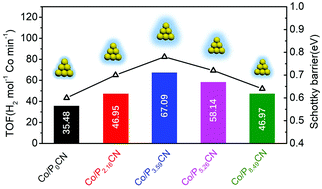Activating Co nanoparticles on graphitic carbon nitride by tuning the Schottky barrier via P doping for the efficient dehydrogenation of ammonia-borane†
Abstract
Herein, a highly active Mott–Schottky nanocatalyst with tunable Schottky barrier was constructed by embedding Co nanoparticles (NPs) into phosphorus-doped graphitic carbon nitrides (PxCN) for the enhanced dehydrogenation of ammonia-borane (AB). Analyses show that P doping can efficiently decrease the work function of g-C3N4 and elevate the conduction band edge potential; thus, P doping offers a simple approach to tune the Schottky barrier of Co/PxCN by varying the doping amount of P atoms. Upon rationally tuning the Schottky barrier from 0.60 to 0.78 eV, the obtained photocatalyst with the molar composition Co/P3.59CN showed a remarkable TOF (total turnover frequency) value of 67.09 mol H2 per mol metal per min for the dehydrogenation of AB under visible light at 298 K, which, to the best of our knowledge, is one of the highest values reported to date for non-noble metal-based monometallic catalysts and is even comparable to those of some noble metal catalysts. This study opens a new prospect for the rational design and preparation of metal/g-C3N4 nanocatalysts with tunable Schottky barriers and provides a simple way to elevate the catalytic activity of these nanocatalysts.



 Please wait while we load your content...
Please wait while we load your content...